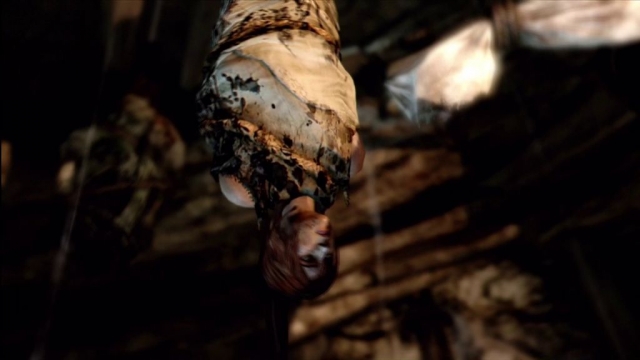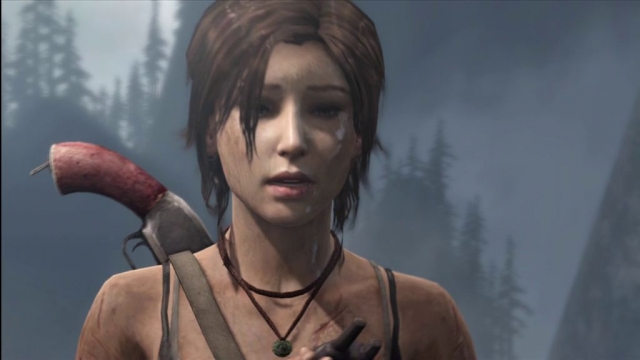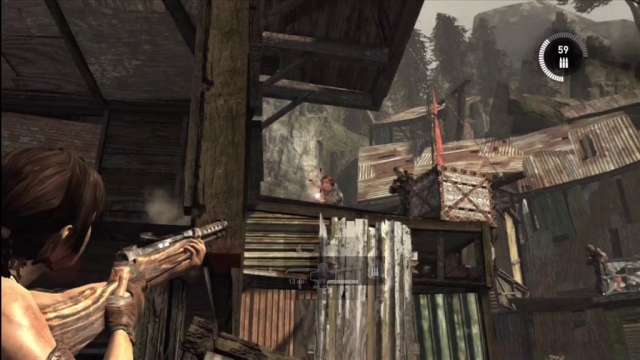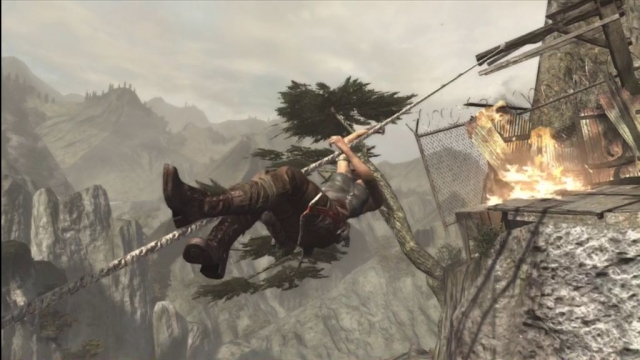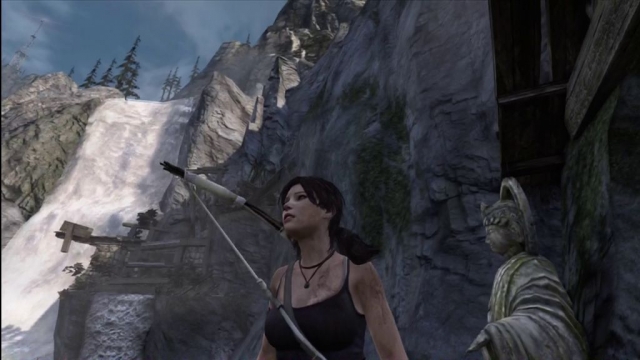Tomb Raider Review
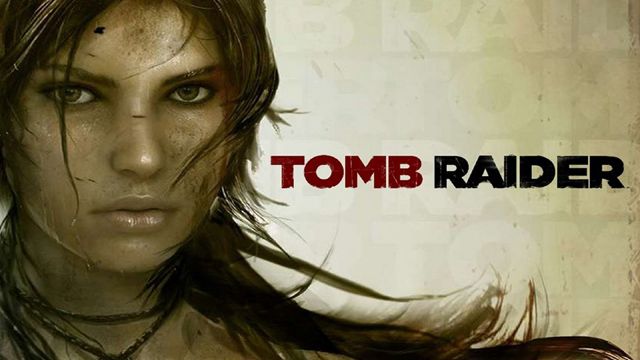
Lara Croft’s road to a reboot has been a bumpy one. The series shot to the top of the gaming industry in ’96, then stagnated with sequels that were too familiar before hitting last-gen systems with a few games that were good, but couldn’t quite recapture the success of past ones, leading to being overshadowed by games like the Prince of Persia trilogy. With that series also going downhill a bit, the current generation has seen the Uncharted series take the mantle as the leading third-person shooter/puzzle solver, leaving the Tomb Raider franchise in the rare position of having to play catch up to something clearly inspired by its past games. It’s somewhat ironic that by taking some cues from that franchise, that Tomb Raider is able to stand atop the genre once again – at least from a gameplay perspective.
From a narrative perspective, Tomb Raider (TR) is better at getting across a sense of survival and makes use of its M rating to showcase graphic imagery that is unsettling, but in a way that makes the violence mean more. Lara doesn’t want to be violent, but her hand is forced. She cries over killing a deer to survive, and even shows remorse for killing a man who attempted to assault her. All she wanted to do was find a hidden city with some of her like-minded friends, and a shipwreck changed the course of all of their lives. Unfortunately, out of the cast of five side allies, only one – an older guy named Roth really seems to have a natural chemistry with her. Alex, the resident nerd, seems to have a crush on her, but it’s never really elaborated on nor is his character really explained in the story.
The same goes for the Generic Irish Stereotype – his name is Grim, but it doesn’t matter; he’s Irish and loves to fight. That’s about the extent of his skillset. Roth’s relationship with Lara isn’t explained very well, but he does seem to care for her as a surrogate father and makes sure to watch over everyone in the group – and since you hear from him over the radio more than the others, he’s given more of a chance to be someone you’ll care about as the story goes on. Addition by subtraction would’ve helped the cast a bit, and if they’d kept it to a few characters instead of making it a Beneton ad, it would’ve made for a more compelling game.
Outside of some problems with the cast, I really love the overall story though. Everything in it revolves around Lara and it’s genuinely compelling. Like the Uncharted (UC) games, things go from plot to setpiece to action with some QTEs thrown in, and the formula is mixed up enough here to stand out while still being very user-friendly for folks used to that series. I definitely prefer the grittier and far more realistic look and tone to the game here than in past TRs and the UC series as well. It makes Lara so much more compelling to see her struggle as a person instead of as a character. Throughout the adventure, she’ll suffer pain that is played up seriously and shown in fairly gruesome fashion. Despite its graphic nature, it never comes off as obscene and instead reminds me more of a nature documentary – there’s violence and bloodshed, but it’s shown in a way that makes it far more effective. You’ll see bloody wounds and actually notice the depth of wounds.
The more realistic approach to things reminds me a lot of Batman Begins – there’s a logical explanation for everything that goes on in the game so that even if it seems a bit fantastical, within the context of the game it makes perfect sense. I also love seeing the weaponry evolve. You go from a makeshift bow to a better one, to a makeshift axe to a steel one capable of dealing out death swiftly, and go from a handgun to machine guns. It isn’t all bang bang bang, though, there’s stealth gameplay here too, and it works better here than in the UC games. You’re also given a number of ways to get through many gunfights, and being stealthy at least some of the time greatly increases your chances of survival. If you’d prefer gunfights to stealth kills, then you’ll be satisfied with what’s offered up here.
Beyond combat, you can use the tools you find to do things like use the bow and arrow to craft a makeshift bridge or zip line or later, unlock the ability to pull objects with the bow, some arrows, and rope. This works on enemies to turn Lara into a much more attractive version of Scorpion, and can also be used to tear down structures – if they so happen to have goons on them that fall to their death, that’s a happy coincidence. The controls are exactly what you’d expect from a third-person action/adventure game – the layout is logical and easy to remember, while the button response time is excellent. The latter is a must given the QTEs used throughout the game, which are done only when they make sense and involve doing more than just hitting a button perfectly. Here, you’ll have to shake the left stick back and forth to wriggle free from the clutches of either a goon or perhaps an animal, and then pay attention to your button prompt to know just when to press the button. What Crystal Dynamics has done allows for QTEs to not feel like a shortcut, and instead finally fulfill their original goal of providing an interactive way to move things along in a game in an engaging way. The single-player game is a home run as a whole, even with a few character-related hiccups.
The multi-player component is well done, but feels antiquated next to the evolving level setups featured in UC 3. Outside of free-for-all, everything is a variant of team deathmatch pitting the good survivors against the evil solarii. Rescue mode has you trying to get medical supplies if you’re on the side of good, while baddies have to try and kill them to prevent that from happening. Cry for help mode is another battle of good versus evil, only here, survivors need to activate radio transmitters while at the same time preventing their batteries from falling into the wrong hands. These changes help differentiate each mode, but really don’t feel all that different from one another.
The best part of multi-player comes from setting traps and then seeing enemies fall for them – it’s incredibly satisfying. The basic shooting is about on par with what you’d get in Uncharted 3, and I prefer the wider variety of weapons here than there. However, there are some technical issues I was disappointed by. I’ve had two games freeze on me requiring a reboot, and the “respawn on friend” mechanic seems to have a tendency to put you back at the starting point…where other allies are. Sure, that’s not technically wrong, but it’s certainly not very practical.
Tomb Raider is an incredible-looking game in nearly ever way. Lara’s character model is incredible, and seeing the wear and tear on her model is impressive. You’ll see things like slices in her clothing – done tastefully folks – and as mentioned before, the depth of wounds. On the more extreme level, you’ll see her get covered in blood in a way that is both realistic and graphic. The only thing that looks wonky is the hair, and even that looks pretty good most of the time. Environments are full of impressive textures and lighting effects that manage to top even UC 3. Character animation is a bit smoother here and seems far more organic and varied than in the UC games. Here, you see more of a struggle against both the elements (ala Journey), and the results of injuries hampering Lara more than just cosmetically. If her ribs are hurt, she’ll clutch them until they heal, and limp on a recently damaged leg. The UC games still take the cake as far as elemental stuff building up on clothing though – there isn’t much rain or snow accumulation on Lara’s gear, and that does affect the reality of things a bit.
Tomb Raider’s sound design is atmospheric and builds up suspense very well with dialogue audio varying in volume depending on how close you are to enemies or allies. One thing that helps the game stand out is the lack of music throughout the adventure. There’s music, sure, but it’s very subdued and doesn’t overpower anything. None of it is very memorable, and yet trying to play the game without it is difficult because it works so well at adding to the suspense. It is there to accentuate the gameplay – not overshadow it, and in that way the soundtrack works very well. It isn’t often that I’ll enjoy a soundtrack that I don’t think would work on at least some level outside of the game, but that’s the case here.
Playing through Tomb Raider results in a myriad of emotions as the game both greatly exceeds expectations in some areas, and yet falls short in others. However, at the end of the day, the single player game is something that everyone should play even if they haven’t loved the series up until this point. I’ve enjoyed an entry here and there, and was blown away by just how gripping the game was. It’s really hard to put down and like the Uncharted series, is something that is best experienced in 2-3 hour play sessions until it’s beaten. It’s definitely not the kind of game you can start, stop, leave idle for months, and get back to instantly.
The gameplay feels a bit more evolved than the Uncharted series, and the next generation of systems is going to be an even bigger godsend for the third-person adventure genre than the current one has been just by having these two AAA-level franchises battling it out. Tomb Raider makes great use of the M rating to tell a rougher, more realistically graphic and violent story than can be told with Uncharted – even with that game pushing the boundaries of a T rating. Tomb Raider’s whole is greater than the sum of its parts, and everything combines to make this the best reboot game on the market today.
Reviewed By: Jeremy Peeples
Publisher: Square Enix
Rating: 90%
——————————————————————————–
This review is based on a copy of Tomb Raider for the Xbox 360 purchased by the reviewer.
 Game Over Online
Game Over Online